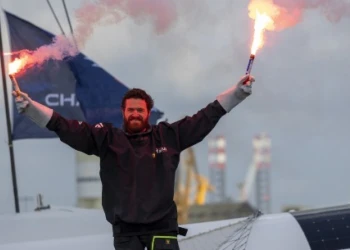
© Charles Caudrelier - Gitana SA
Ice exclusion zone, how does it work?
Every Sunday, we try to offer a new insight, develop a concept, or drill down into a key topic. Today we look at the 'what and why' of the ZEA, the Antarctic Exclusion Zone which is a limit line not to be crossed by the skippers.
It is set up to protect the solo racers from icebergs which drift in the south of the Indian and Pacific Oceans. This demarcation line is fixed by the Race Direction according to the recommendations of CLS (Collection Location Satellites) which are regularly updated. With four skippers currently race along this ZEA, Jimmy Viard, satellite imagery analyst at CLS, explains the challenges.
Why is this ZEA necessary?
Our objective is to provide race management with all the elements to fix the correct position of the ZEA. Three months before the race, we collect data using altimetry (use of a technique designed to finely measure variations in ocean levels), radar and optical imaging. This allows us to determine the areas of risk in terms of the quantity of icebergs. We then present our results to Race Direction. During the race, we can refine the ZEA by using radar satellite imagery which allows us to determine the positions of the icebergs. We are already on the 4th update since the start.
You modified it recently?
Yes, last weekend for the area by the Kerguelens. Because of the analysis of satellite images, three detections of 40 meter objects were observed. These might indeed be boats which do not use AIS (an anti-collision system fitted and used by all vessels and which allows them to be identified) as they are fishing illegally. We didn't want to take any risks at all and so we decided – in collaboration with the Race Direction - to move the line up to the north just a bit.
"Icebergs can exceed 10 km!"
As well as observing icebergs, you model them?
Yes totally, we model icebergs. By determining their volume and height and knowing the currents, winds and water temperature, algorithms are able to model their drift for several days. It is very reliable for three days, less precise after that. This allows us to anticipate their drift and ensure that no iceberg is actually close to the ZEA.
How big are these icebergs?
The bergs we detect can exceed 10 km, or sometimes more than 100 km. These are pieces of Antarctic glacier which drop into the sea which break up and which manage to extricate themselves from the ice floe and come north on the current. Larger ones are renamed with a letter and number by the United States National Ice Center. As they drift, mainly with the currents (and to a lesser extent with the wind), they break up into large pieces. We can see and monitor pieces of ice at 40 meters and bigger. Below it becomes complicated since they can be confused by breaking waves.
Are there more or less than in previous years?
This year in the South Atlantic, it's a real minefield full of icebergs! Some managed to escape because of the current, others broke apart as the water warms up. In the Atlantic, there is a current from West to East which takes them from the Antarctic Peninsula and they drift towards the Kerguelens and 'die'. In the Pacific, they come from the Ross Sea to Cape Horn. It depends each year on the number of icebergs that leave Antarctica and that varies greatly. In the Pacific, for example, we are seeing significantly fewer icebergs this year than last year.
"They are not going further north than usual"
Does global warming have an impact on this?
In truth we do not really know from the sphere of our work if this is due to climate change. On the other hand, what we see is that the blocks released from the glaciers are increasingly larger. If the block extricates itself thanks to the current and manages to get out to the North before winter imprisons it, it will advance, fracture and continue on its way. Sometimes, it can "live" an entire year or even years in the South Atlantic. However, they do not go further north than usual, around 44° South in the Atlantic.
During their record attempts, Thomas Coville and François Gabart went much further south than our skippers?
Yes. Totally, but these are two different things, racing and going for a record. The round-the-world record attempt has no limit imposed on the course. There we work directly with routers. Here the Race Direction has a responsibility to ensure the safety of the skippers, hence the need to establish the ZEA, and then the ZEA must remain valid for the last competitor who might pass a long time after the leader.
What could be optimized or improved in the future in this field of work?
We currently use commercial images of 500kmx500km with a resolution of 80 meters by programming them precisely where you want. We also use data from the European Sentinel satellite on areas defined well in advance by the Copernicus program but coverage in the big south is weak. There would need to be a satellite mission that permanently programs images before and during the race. The costs are still substantial.







